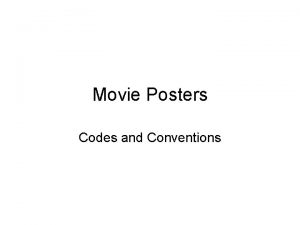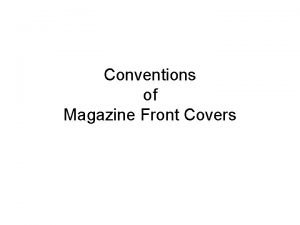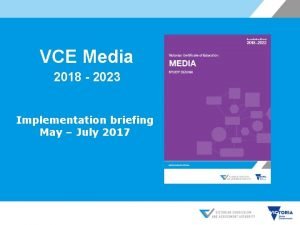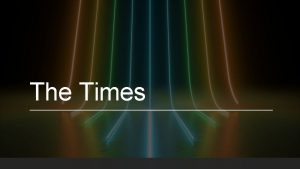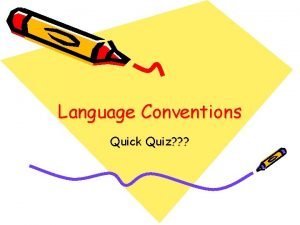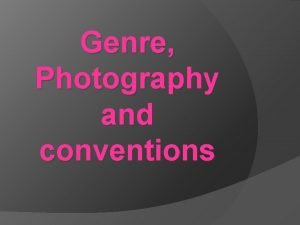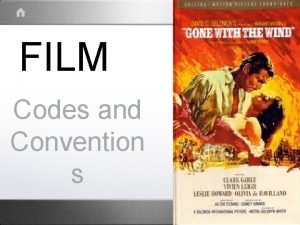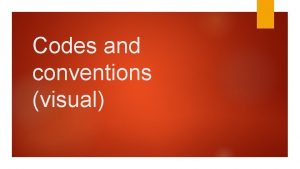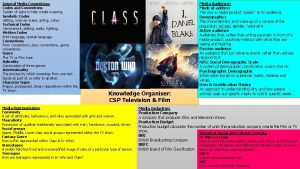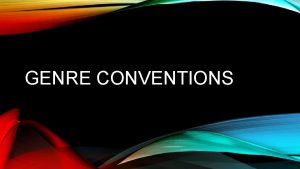Codes and Conventions of a regional magazine MEDIA







- Slides: 7

Codes and Conventions of a regional magazine MEDIA A 2 GRACE HALLAM

The Three Codes: What are codes and conventions? Codes and conventions are the familiar and predictable forms and techniques used by the media to communicate certain ideas or to convey a desired impression. Technical codes include camera angles, sound and lighting. Symbolic codes include the language, dress and actions of characters. • Technical codes - camera codes, depth of field, lighting and framing • Symbolic codes - settings, miseen-scene, clothing and colour • Written codes - the language and the effect it would have on the audience • The codes and conventions of a regional magazine determine the response of the viewer and the way it is perceived.

What is included in a regional magazine? A regional magazine will still feature all of the normal codes and conventions featured in other mainstream and niche magazines. For a front cover, these include: Masthead - A clear and bold title that features the name of the magazine Cover Stories - What the magazine features and persuades the reader to buy the magazine by giving a sneak peak into what the magazine consists of. Barcode Advertisement - For a regional magazine, these would likely include advertisements for local businesses and other things that are suitable and appropriate for the region. Large image - This usually fills the whole page and normally focuses on something in particular such as the local area.

For a contents page: Columns - maybe 2 -3 of them. Name of the magazine - this can sometimes be featured at the top of the page. Page numbers - next to or on the image in the contents page. Often covers 1 -2 pages - quite often a double page spread. Information - sometimes the magazine’s social links appear on the contents page. Sub-lines/sub-headings - these offer insight into the magazine and what it will feature. Images - possibly one main image with text or multiple little images to show the multiple stories in the magazine. Issue date - this almost always features somewhere - usually the top of the page in the right hand corner. Colours - are usually the same as the front cover colour scheme to be in keeping with the house style. Text - could be bold or a different colour to intrigue the reader into reading on.

For a double page spread: Usually large images that take up most of the page space with text dotted around in the remaining spaces. Laid out with the images running along the top and side of the pages with minimal text in the bottom half of the two pages. The picture to text ratio is quite rarely equal with more images than text. Bright images and plain text featuring images of the subject of the magazine; i. e. Nature in that area for a nature magazine. Informative articles with relevant images. Possibility of competitions at the end of the articles to engage with the reader.

Photography in regional magazines Photographs used for regional magazines tend to be that of a singular person or that of a location within the chosen region – for example, the Spinnaker Tower is commonly used for regional magazines set in Portsmouth. If the photograph features a person for their front cover image tend to be staring straight into the camera and in most cases the model used in the photograph has a darker background behind them to illuminate and make them stand out so the attention of the audience is on them. The images will reflect theme of the magazine so entertainment magazines set in London for example, will feature an image of the O 2 or similar entertainment venues. This allows the reader to understand what the magazine will be about before they have even read the magazine to allow them to make a quick decision whether or not they want to read it. Therefore, the image needs to be of a really high standard and needs to be striking so that it makes a good impression on the reader.

Layout of regional magazines: The layout of nearly all regional magazines include a bold masthead and striking image that both intend to grab the readers attention. The masthead is nearly always written in a large font in a contrasting colour to make it stand out from the background image(s) so it is the first thing people see when they look at the magazine. The images are relevant to the subject of the magazine and are well edited to make them stand out from the rest of the regional magazines on offer. The image is never of a celebrity or another famous person because it is about the people living in that town or city and the normal people you see on a day to day basis. They nearly always follow a set house style with every issue so that it is easy for the people wanting to buy the magazine to recognise it, especially if there is multiple regional magazines for that area. The colour scheme for most regional magazines is that of their town crest as this is what people most closely associate with the area – for example, a magazine set in Portsmouth would have a colour scheme of blue, white and gold.
